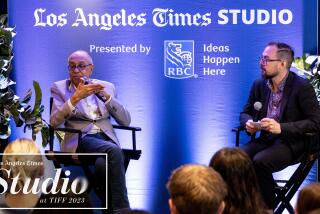The Man, Feeling Out of Place at a Movie
- Share via
I actually saw “Sweet Sweetback’s Baadasssss Song” (1971) during its first run. I was a young white teacher in one of Philadelphia’s several all-black, or mostly black, high schools; I also had the distinction of teaching one of the few accredited courses on black American history that year. “Sweet Sweetback” was in its third sold-out week at Philadelphia’s Milgram Theater, one of its very few remaining downtown movie houses, and several of my students, mostly male, had seen it repeatedly.
A couple of them “dared me” to sit through it. So, one weekday afternoon, I joined the huge crowd on Market Street for the 4 p.m. show. I could feel all those eyes on me as I stood there shivering from the bitter cold, alone, since my student “escorts” had yet to show up. Finally, as I got to the box office, the cashier, an older white woman, gazed up at me through her protective glass and muttered in that distinct Philly twang (think Stallone), “You sure you know what you’re doin’ here, hon?”
Just as I plunked down my admission, my students arrived. “Here to protect you, Mr. M. You’re treatin’, right?”
We sat in the balcony and the crowd, already familiar with the routine, started talking to the screen. (Just picture yourself at an intimidating version of “The Rocky Horror Picture Show.”) The opening freeze frame--”This movie is dedicated to all the brothers and sisters who have had it with the Man”--brought down the house.
I tried to follow the film’s loose narrative, without letting my self-conscious discomfort overwhelm me. Like many whites of my generation, I was anxious to disavow racism and bigotry. Still, I knew my limitations in an environment that simply wasn’t safe for its own inhabitants. Gangs, drugs, domestic violence, predatory crimes of all sorts were too common in this neighborhood. I was never so naive not to prioritize my own safety. Yet, I don’t think I ever felt as uncomfortable or as out of place as I was in the balcony of the Milgram at that moment. After all, I was “the Man,” and in those opening seconds of the film, I knew this was no place for any white guy. Testimony to the power of the film.
After a few more minutes, however, I began to realize that Melvin Van Peebles had not really made a black racist harangue after all. “Sweetback” soon dissolved into a groovy little R&B; “video” (there was no name for it then) with lots of zooms in and out of our hero in his pimp suit running and running, then doubling back for a little guerrilla warfare with an endless array of rednecks in pursuit. Van Peebles’ funky little score orchestrated the action. “Run Sweetback, run . . . “ was the vocal track, and the audience chimed in “Run!”
There were a few bursts of violence in the film, but this was a far cry from “The Wild Bunch.” And the sex scenes were staged for laughs--among them, the hero’s “duel” with a white buxom Amazon leader of a biker gang. No feminist sensibilities here.
By the end I realized that “Sweetback” was a cathartic, well-timed, hip fantasy, with lots of broad “in” humor turning old stereotypes upside-down. There was just enough “get Whitey” to make its young black audience feel, probably for the first time, that someone had made a movie just for them.
As I exited the theater, relieved that it was over, that I was safe, and that the movie actually had a positive side, my students asked for my reaction. I muttered something like: “I liked the beat . . . “ and hastily headed for my car.
More to Read
Only good movies
Get the Indie Focus newsletter, Mark Olsen's weekly guide to the world of cinema.
You may occasionally receive promotional content from the Los Angeles Times.










